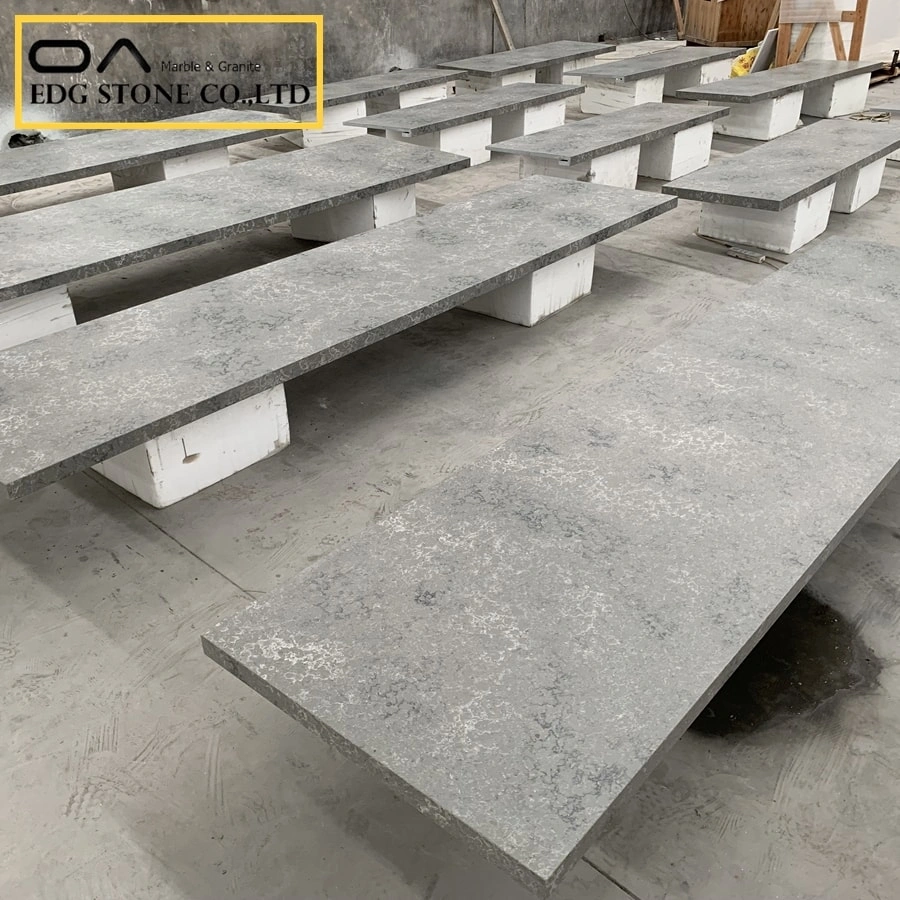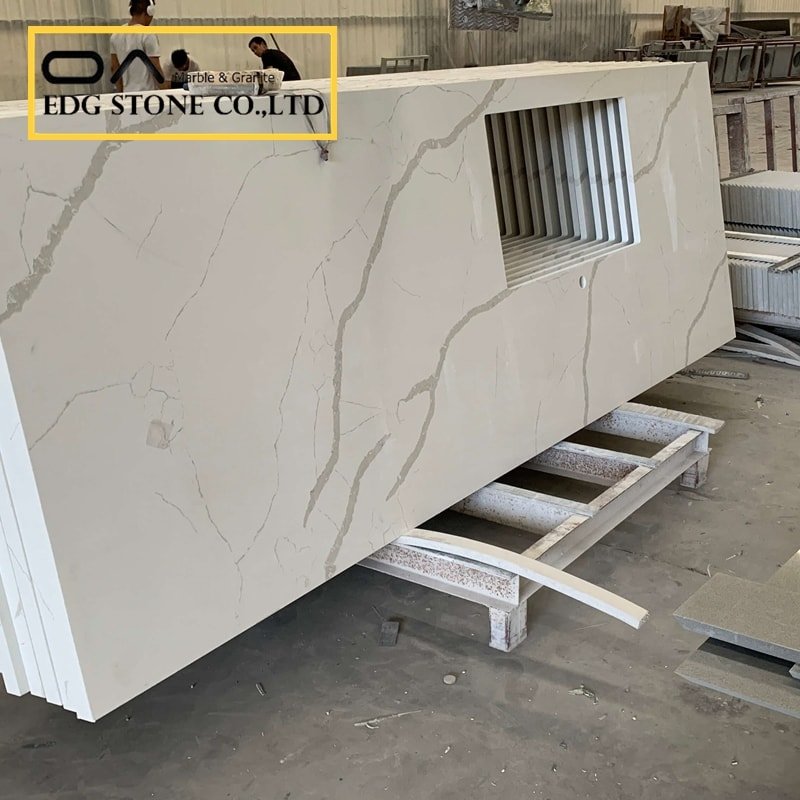People generally like to use marble as the decorative countertop of the vanity, while the floor and wall of the bathroom are decorated with relatively high-end natural stone, which adds a somewhat elegant atmosphere to the bathroom. Marble is also called metamorphic or recrystallized limestone. Real marble is a calcite metamorphic rock with a crystal structure. Marble is derived from limestone based on the metamorphism of regional stone. Generally, it contains large, rough crystals, of which calcite accounts for more than 99%. The crystal is visible to the naked eye, especially on its cross-section. The main components of marble are calcite and calcium carbonate, with a Mohs hardness value of about 4.5.
Polished marble is suitable for paving on vertical surfaces (such as walls). In addition to the function of protecting the wall, its other natural characteristics, such as smooth surface, beautiful color, and natural texture, are very suitable for beautifying the bathroom environment. But its disadvantage is that it is soft, acid and alkali resistant, poor weathering resistance, easy to absorb oil, water, and other liquids and be contaminated, easy to be scratched, and not abrasion-resistant. Almost all cleaning and stains containing acid and alkali will be affected. Marble causes damage. For example, the vinegar, lemon juice, orange juice, cola juice, juice, etc. used in daily life are all acidic. If a small amount is spilled on the surface of the marble, it should be wiped and cleaned immediately. A longer residence time will damage the marble and lose its luster. If it is used in the bathroom, daily maintenance and protection must be done. Because marble is easier to refurbish and has a lower cost, it can be refurbished at any time after using the old on a larger area of the ground.
Granite is mainly composed of quartz (35%), feldspar (45%), and feldspar. The Mohs hardness value is about 6.5, the color is usually dark, and some also contain a very small amount of calcite. Crystals with mineral particles can be seen on the surface. According to the proportion of quartz, mica, and feldspar, granite can also be subdivided into many types. The advantages of granite are high hardness, acid and alkali resistance, abrasion resistance, and strong weathering resistance. It is suitable for exterior walls, floors, corridors, stairs, kitchens, bathrooms, and other parts of buildings. It is easier to maintain than marble. However, the color tone and texture are relatively simple, and the repairability is poor once it is worn out. Therefore, it is more suitable for use in areas that may be exposed to acid solvents, such as bathroom countertops, kitchen stoves, window sills, and sanitary walls. In the selection of the ground, consideration should be given to the poor repairability of granite, which is difficult and expensive to refurbish. Once paving, uneven interfaces will appear, or it will be difficult to deal with when it is worn out in the future. Among the polished surface stones, granite is the hardest and can be used in places subject to high pressure. But its surface also has pores, which can also be contaminated.
Some stones are naturally suitable for use in bathrooms. For example, harder, denser marble is more suitable than softer, higher water absorption marble. Light-colored stones are more resistant to slight soapy water pollution than dark-colored stones. Therefore, it is recommended not to use green serpentine and black marble in the bathroom, so that the possibility of contamination on the surface of the stone is relatively small.
Although natural stone is a high-end decorative material with natural beauty, its naturalness and the diversity of mineral structure determine that the stone itself will have different degrees of defects and problems. The seemingly hard stone is actually very delicate and requires careful care during paving and use. Because the bathroom has the specific function of bathing and has a lot of water vapor if the stone laid is improperly maintained, it is very easy to be contaminated. Common pollution is caused by mold, dirt, and bacteria. The surface of the stone often becomes dull and dull and produces a cloud-like circle of white stains. The daily problem is the pollution of bathroom marble by soap and shampoo. The damaged stone surface is rough and dull. The original beautiful and smooth polished surface loses its mirror luster, cannot clearly reflect the scenery, and the pattern lines become blurred. To avoid this situation, it is best to use dye-free shampoos and soaps and shampoos that do not contain artificial colors.
People also often encounter such problems: the marble in the bathroom becomes dark, severely damaged, and the surface gloss disappears. If you encounter such a situation, you need to polish the surface. High-quality polishing agents are available in large domestic building materials supermarkets, such as OBI building materials chain supermarkets. The polishing agent is usually composed of two components: polishing powder and polishing liquid. The polishing powder contains fine particles of oxides such as aluminum oxide or tin oxide. The main component of the polishing liquid is a surfactant and does not contain acid. Manual polishing is suitable for small areas of the surface, while machine polishing is used for large areas where the surface is damaged and dull.
If it is a family bathroom, you can do it yourself (DIY). In the specific operation, mix the two components (polishing powder and polishing liquid) into a paste, apply it to the surface, and polish it with a white polishing cotton pad. Very good results. If you don’t have a special polishing pad at home, you can also use the non-woven fabric commonly used in the kitchen to polish it with polishing products, which can also have a certain brightening effect. It is recommended not to use fine sandpaper because that will cause slight scratches on the stone surface, which will make it more difficult to handle.
If it is a toilet, bathroom, etc. in a large public place such as a hotel, guesthouse, etc., you can operate according to the following procedures:
(1) Ensure that the surface is dry and has not been protected by a protective agent. If necessary, use a neutral cleaning agent to clean the surface first to make the stone surface clean and dry, ready for the next polishing.
(2) Use the spoon that comes with the product to remove the polishing agent liquid to the surface, and then sprinkle the same amount of polishing agent powder. Use half a spoon of powder and polishing agent liquid on each square foot (O.0929 square meter) of the stone surface.
(3) Use a ground grinder (175-$50 rpm) of 100 to 140 pounds, or a hand grinder (1,500-2,500 rpm), with a white nylon pad (preferably 5M polishing felt) Pad), wool pad, burlap or other non-abrasive polishing pad for polishing. Polish the ground to be treated, and polish 6-8 square feet (0.56-0.74 square meters) at a time until the brightness is restored.
(4) Rinse thoroughly with clean water, then polish with a cotton cloth to make it shiny.







